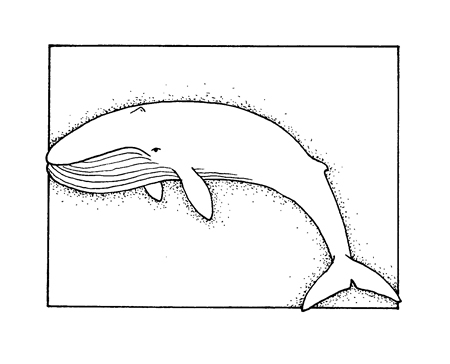By Jan Sattler and Mia Davidson
Although July through September is the prime viewing time for the blue whale (Balaenoptera musculus), so far in October our behemoth visitors are still hanging around and easily seen from Laguna’s cliffs and hills. The blue whale is believed to be the largest animal ever to have existed, averaging 80 feet in length. So named because it appears blue underwater, the whale is actually a mottled bluish-grey with a light underside. It has a streamlined body with two slender pectoral flippers, a small dorsal (top) fin located three-quarters of the way down the body and a tail that is approximately 15 feet tip-to-tip and consists of two broad flukes. Like all baleen whales, it has two side-by-side blowholes and their blow is tall and straight and can reach over 20 feet. They are thought live 80 to 90 years on average.
Rather than having teeth, blue whales have baleen plates that filter a diet that consists primarily of krill, a small shrimp-like crustacean that is found in the cold upwellings of nutrient-rich waters just off the coast from San Diego to Monterey. As members of the rorqual whale family, they have long pleats that allow the throat to expand when they gulp in large amounts of krill and water. They can consume many tons of krill each day and much of their local movement is attributed to following the krill. Found in every ocean of the world, many details about their seasonal migrations and destinations are still unknown. Traveling mostly in pairs but sometimes singly or in small, loose pods, they swim in summer to northern latitudes for feeding, and in winter to southern latitudes to breed and give birth. Gestation lasts approximately 12 months and calves are born in intervals of two to three years.
The large size of the blue whale prevents most predation but orcas have been known to attack calves and vulnerable adults. Commercial whale hunting existed from the early 1900’s until 1966, which decimated the blue whale population from its estimated 250,000 to 350,000 peak to less than 15,000 estimated today. In addition to general environmental degradation and noise pollution, the main dangers are from entanglement in fishing gear and boat strikes as shipping lanes and migration routes intersect.
Since worldwide hunting was banned, the blue whale numbers may slowly be increasing, but it is still on the world’s endangered species list. Recovery of the population that pass along the California coast is thought to be greater than other populations around the world. Although there have been recent sightings just a quarter mile off of Crescent Bay and Crystal Cove, most consistent blue whale observations have been in the mornings and late afternoons with the animal swimming just a few miles off shore. Look for spray from their blows and light or dark crescent-shaped interruptions of the ocean surface near the horizon.
Residents and year-round ocean swimmers, Mia Davidson and Jan Sattler are trying to foster environmentally responsible stewardship of our local ocean resources.





